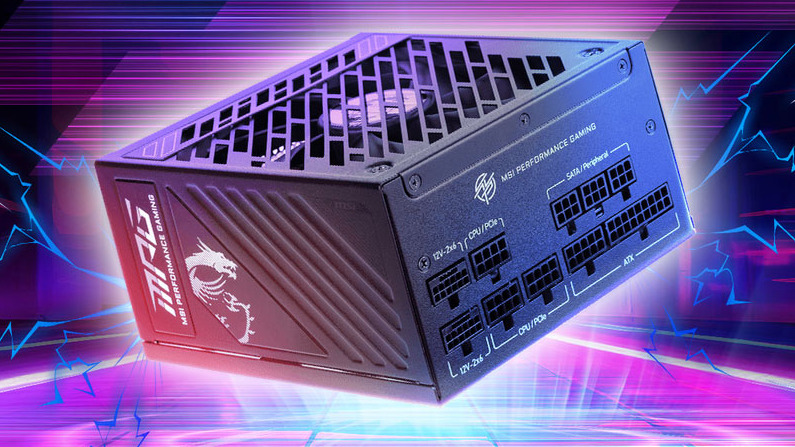GPU compatibility dilemma brewing as more high-end power supplies ditch 8-pin connectors in favor of new 16-pin
MSI's PSUs appear to have been engineered with the RTX 40-and RTX 50-series GPUs as the primary target.

Since the 16-pin connector was introduced and later revised, melting adapters and PSU/GPU-side connectors on some of Nvidia's mainstream GeForce gaming GPUs have been rampant. Two of MSI's recently launched high-wattage PSUs interestingly feature two 12V-2x6 connectors while providing only one standard 8-pin connector (via OC3D). Unless you get a 12V-2x6 to 8-pin adapter, these PSUs are incompatible with most modern-day GPUs from AMD, Intel, and even Nvidia (RTX 30 and prior), apart from a few specific variants.
The industry (or, more specifically, Nvidia) made the shift towards 16-pin connectors to reduce cable clutter and meet the ever-increasing power demand of new GPUs. After the first GPU meltdown wave hit, the 16-pin standard was revised with pin length changes and is now known as 12V-2x6. Reports of melting RTX 50-series GPU connectors and adapters have been making rounds on the internet, even with the improved standard. This time, it is believed Nvidia's power delivery design might be partially responsible.
It seems the industry is catching on to the 16-pin standard, even at the cost of reduced compatibility with other GPUs. MSI's MPG A1000GS and MPG A1250GS power supplies, targeted at high-wattage GPUs, include two native 16-pin connectors and only a single 8-pin (6+2) connector. If you buy an additional 6+2 connector separately, you can only use a single 8-pin for the CPU, potentially hamstringing CPU performance.
Theoretically, a 225W TGP GPU or lower, like the Intel Arc B580, can easily be powered by one 8-pin connector. However, AMD's Radeon RX 9070 series cannot, as these GPUs typically require two or three 8-pin connectors.
The Shift From 8-pin To 16-pin Power Connectors
To be clear, this isn't the first time we've seen such an implementation. Galax's GH1300 also shipped with a dual 16-pin design, but that PSU was a one-off and unleashed to tame the RTX 4090 HOF that could quickly chug up 1kW of power. As of writing, there isn't any RTX 50 series GPU with multiple 16-pin connectors, so the full potential of these PSUs remains untapped. Nvidia recommends a 1,000W (minimum) PSU for the RTX 5090. This raises concerns about the MPG A1000GS, which is borderline on recommended specs yet ships with two 12V-2x6 connectors.
All things considered, equipping PSUs with multiple 16-pin connectors is counterintuitive for most consumers, especially given the standard's original goal to simplify cabling. For maximum user flexibility, a PSU design should include one 12V-2x6 connector alongside multiple 8-pin connectors to accommodate high-power GPUs from either brand.
Get Tom's Hardware's best news and in-depth reviews, straight to your inbox.

Hassam Nasir is a die-hard hardware enthusiast with years of experience as a tech editor and writer, focusing on detailed CPU comparisons and general hardware news. When he’s not working, you’ll find him bending tubes for his ever-evolving custom water-loop gaming rig or benchmarking the latest CPUs and GPUs just for fun.
-
hotaru251 I mean its msi so not shocking given they basically done making AMD gpu's.Reply
So them going all in on nvidia adapter makes 100% logical sense. -
ezst036 The spread of this will likely force AMD into using that 12VHPWR connector.Reply
As long as AMD treats that connector the way Nvidia did on the 30x0 series and not the 40x0 and 50x0 series of video cards by separating the power, AMD will be fine.
The 30x0 cards didn't melt. The connector isn't the problem, these power supplies aren't the problem. Nvidia is the problem. There isn't any reason they should have gone super cheap on this. -
endocine Reply
The connector has physical issues, bend radius, carries too much current in too small of a form factor with thin wires, proper insertion.ezst036 said:The connector isn't the problem -
BillyBuerger You really don't need a 1kW unless you're powering one of nVidia's stupid high power cards which will use these connectors anyways. So it makes sense that these PSUs focus on that. But also, if you wanted to power a more reasonable GPU that uses a couple 8pin connectors, you can just use a 12V-6x2 to multiple 8pin cable adapter. Yes, now you need an adapter to go back instead of one to go forward but at least doing it this way likely won't cause the same melting issues.Reply -
truerock Asus ROG Astral RTX 5090 has per pin monitoring (called Power Detector+) which monitors amps and volts on each individual wire/pin of a 12VHPWR connector. A rough estimate is it might have cost Asus $100 on each card to do that because it is a custom thing. If Nvidia did it on all cards, the price would probably be less than $20 per card.Reply
From a cost perspective, it doesn't seem possible for PC PSUs to do that for each wire in each pf its plugs. It would be great if PC PSUs could do it - but, it isn't likely to happen any time in the immediate future.
But, if this MSI PSU had that feature and it added the cost to just the 12VHPWR plugs, I guess that might happen.
To me, the reason that this is an issue is because 50amps is a mind-boggling amount of electricity for a run of the mill consumer to deal with. My electric oven and my electric clothes dryer pull 30 amps. Have you ever noticed how thick a clothes dryer electric cable is? -
das_stig Cable isn't the problem, it's Nvidia making power hungry GPUs when they should be making each generation less hungry and I put it down to lazy designs and engineering, with nobody really challenging them !Reply -
alceryes Reply
I disagree.ezst036 said:The connector isn't the problem...
Versus 8-pin, the safety factor was lowered too much and the gauge of wire is inadequate for the potential power draw across just one or two wires (if no extra shunt resistors are used).
The reason why the 3000-series FE 12VHPWR cards were ok is because of the extra shunt resistors NVIDIA had on all these cards. These resistors are NOT part of the connector spec and actually masked the inadequacies of the 12VHPWR connector.
If shunt resistors are required on the GPU to make a connector design safe, then the connector design itself is still at fault. -
ezst036 Reply
I can see the logic. That explains very well why the RTX 30x0 series never melted. (or at least, was so one-off and so random that its practically unheard of)alceryes said:These resistors are NOT part of the connector spec and actually masked the inadequacies of the 12VHPWR connector.
If shunt resistors are required on the GPU to make a connector design safe, then the connector design itself is still at fault.
Still doesn't explain why Nvidia has not abandoned their terrible decision to use that connector in the first place. Besides, there's nothing that prevents Nvidia from going off-spec to protect its own customers. They did it initially for 30x0, why not keep doing it.
For reference:
https://www.tomshardware.com/pc-components/gpus/nvidias-rtx-5090-power-cables-may-be-doomed-to-burn
https://cdn.mos.cms.futurecdn.net/MJzPaCkPWQSKV8xTRmHUsj-970-80.png.webp
Melting video cards is not a good look. It doesn't matter who the company is.
I sincerely hope AMD requires the use of the three stage shunt design among its card distributors in order to diffuse the cable/power delivery so it doesn't melt following the model of the 30x0s. It would put AMD in a no-excuse situation to have melting video cards after all Nvidia has put its customers through. -
thestryker Regarding the PSUs not being compatible: if you're buying a PSU with two 12VHPWR/2x6 connectors you're not worried about 8-pin PCIe.Reply
Regarding the spec:
According to Buildzoid the PCI SIG specifications for the connector is supposed to have all pins connected together. That means the design nvidia used with the 30 series wouldn't actually adhere to the specifications despite being a much better way to implement the connector. It's wild to me that manufacturing variance was apparently never taken into account when designing this specification.